Vive XR Elite review: A good argument for a Quest Pro
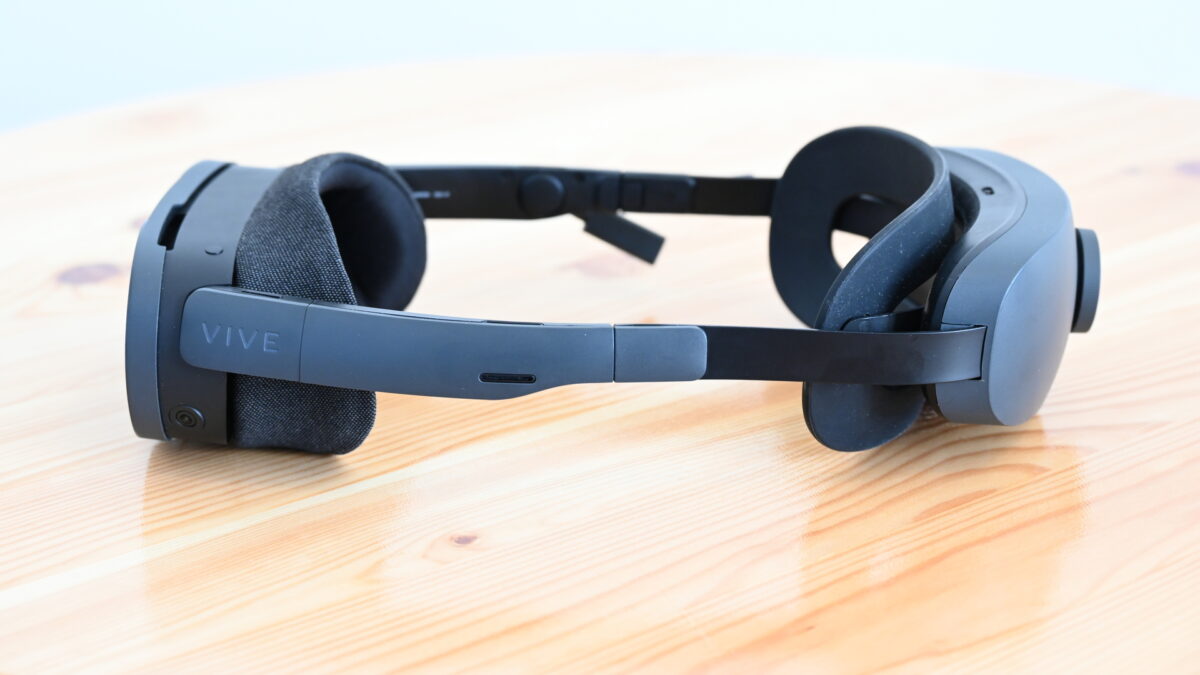
The Vive XR Elite has so much potential. And it does so little with it that the Quest Pro easily walks away as the winner.
There's a common theme to VR headsets from HTC: A lot of hope in the run-up and good previews but only disappointment in the review. The Vive Pro 2 was a lens disaster, the Vive Flow was out of the question, and only the B2B headset Vive Focus 3 was somewhat convincing (apart from the lenses).
In this new attempt, HTC wants to market directly to home users again after a long time. My preview directly praised the Vive XR Elite, and the short play session was very promising. Then it became time for a more thorough, full review again.
Content
Vive XR Elite test in a nutshell
The Vive XR Elite feels like a design experiment carried out at the customer's home. The headset is super slim, very light in the front, modular, has a visual acuity adjustment built in, pancake lenses, and can be equipped with glasses temples. So far, so great.
But the lenses show bad glare, as well as mura, and the internal reflections party harder than on the Pico 4. The image looks like you're looking through a steam bath in high-contrast scenes. The field of view is smaller than that of the Quest Pro, and the face mask is only a narrow protective flap that presses very uncomfortably after 30 minutes due to the plastic bar above the eyes.
Wi-Fi streaming only works smoothly enough in performance mode. The speed at which SteamVR is available is remarkably good, though. In goggle mode (without the battery at the back of the head), it's just as useful as the Vive Flow — almost not at all.
The passthrough is not depth-corrected, but it offers a sharp image that also lets you read on-screen text at short distances. All in all, the Vive XR Elite is an experiment that shows what form factor VR or XR headsets can take in the future.
That being said, there's no reason to spend $1,099 on it. Really none.
Vive XR Elite is suitable for you if you ...
Vive XR Elite is not for you if you ...
- expect a clean, clear image without glare and reflections,
- need a really comfortable headset,
- expect smooth streaming from your PC,
- want easy streaming from your smartphone, or
- depth-correct passthrough AR.
Setup, configuration, IPD, tracking
First, I pair the VR headset with the Vive Manager app and set the Wi-Fi network there. After that, I'm guided through setting the lens focus as well as the interpupillary distance. The former works easier if I know my diopter values. Otherwise, I have to visually assess the sharpness via a green cross while turning the dial on the lens with two fingers. On the other hand, the IPD (54 - 73 mm) is convenient, and I adjust it with a slider underneath the headset.
After that, I define the play area, similar to drawing a guardian on other standalone VR headsets. That's about it — the setup is really quick and easy.
However, I keep encountering bugs in the app, such as not being able to switch to settings or connected devices from the Store view. Also, mirroring my smartphone into the Vive XR Elite doesn't work immediately, and I have to manually connect with Miracast/Screencast.
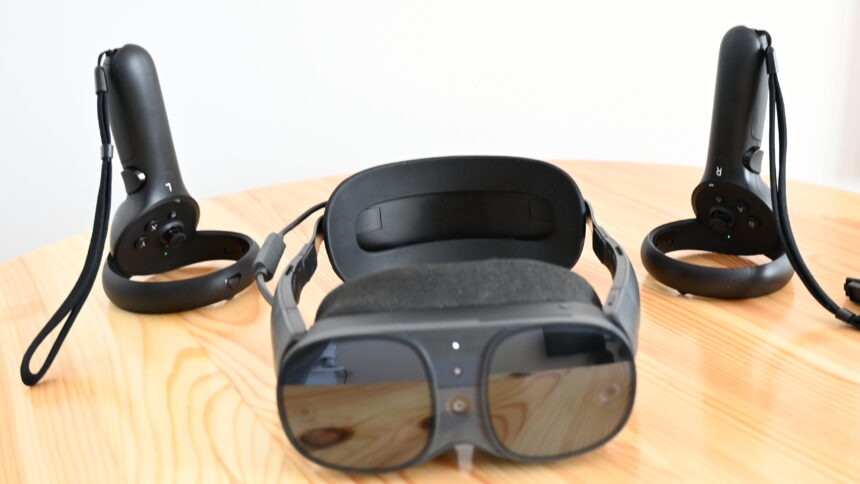
The Vive XR Elite comes with the rather large Vive Focus 3 controllers. | Image: MIXED
Tracking, of both the VR headset and the large Focus 3 controllers, mostly works great in good light. However, I also noticed bugs here several times, such as when switching from outside the gaming area back in and vice versa. The controllers are sometimes displayed too low and the laser pointer too high, but the tracking still works.
Hand tracking works surprisingly well but is still not good enough. Too often, finger positions are misinterpreted as a pinch, which is register as trigger pulls or clicks. This leads to unintentionally starting apps and games.
The battery lasts a maximum of 2 hours and takes about the same time to recharge.
Vive XR Elite: resolution, colors, frame rate, image impression.
The XR Elite has a resolution of 1,920 x 1,920 pixels per eye, slightly above the Quest 2 (1,832 x 1,920), the Quest Pro (1,800 x 1,920), and below the Pico 4 (2,160 x 2,160). Colors are significantly less vibrant than in the Quest Pro but on a similar level to the Quest 2.
I see slight mura, pixels of different brightness on the display that lie over the image like a veil. This is usually not noticeable in applications. However, it, unfortunately, intensifies the generally poor picture impression. The glare, the halo around bright objects (such as white text), and the internal reflections are so strong that I look through a fog in high-contrast, bright scenes. Add to that a narrow sweet spot and the fact that the image becomes very blurry at the edges, so bad that text at the sides and bottom is completely illegible.
I also have a problem with the fit. I would actually have to wear the front of the Vive XR Elite glasses a bit lower to really hit the sweet spot. But that's impossible — I can't push the VR headset lower on my nose since the nose gap is too narrow. If I look straight ahead, I'm just barely in the sweet spot, but if I let my gaze wander down a bit, the blur is extreme. UI errors aggravate this problem. Often, notifications (about updates, for example) are displayed so low in the image that they are completely illegible.
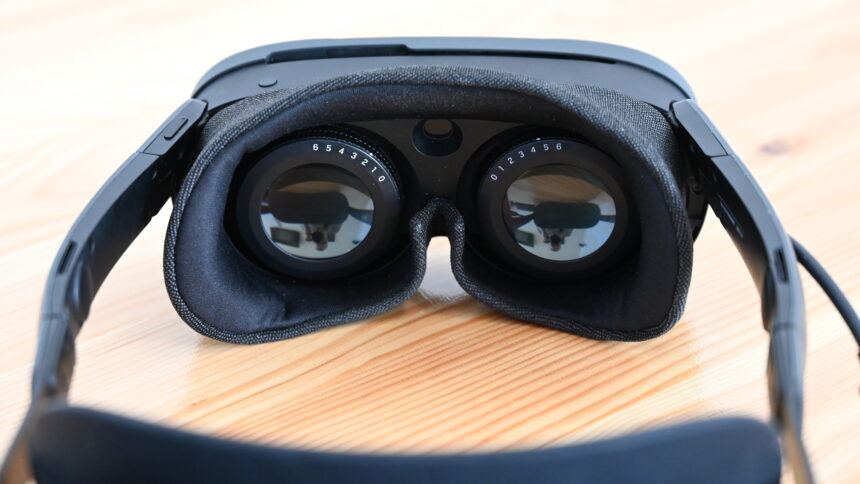
The dials for adjusting the visual acuity are located on the lenses, but only up to -6 diopters. | Image: MIXED
In scenes with a black background and the white laser pointers of the controllers or the white displayed virtual controllers themselves, I clearly see several reflections of the virtual object, like a graphic echo, partly colored. This is really unattractive.
In addition, there are slight bulges and the impression that the image sometimes moves slightly, as we've seen in 3DOF glasses. I noticed this when I looked closely at the clouds or the space whale flying along in front of the window in the home environment.
Fortunately, this is not so dominant in apps and games — I get used to it. But if a direct comparison to the Quest 2 seems like a huge improvement in image clarity, it's evident that the Vive XR Elite's lens and display design needs improvement.
According to HTC, the field of view is 110 degrees, which is supposedly larger than that of the Quest 2 (95 degrees). That definitely does not add up for me. On the contrary, I have the impression that the field of view of the Quest 2 is at least as large as the XR Elite, and that of the Quest Pro is even larger.
Passthrough & AR (Mixed Reality)
The color passthrough is really good, even if it does not provide a stereoscopic, depth-correct image. Unlike the Pico 4's color passthrough, which brings heavy distortion and fisheye effects, here I see a magnified but smooth 2D image of my surroundings. That means I cannot properly judge distances, for example, when I want to write on a whiteboard or type on my smartphone. But at least the image is sharp enough that I can read my watch or smartphone at arm's length. This helps a lot when the software requires me to adjust settings outside the headset, such as when starting the Vive Streaming Hub and SteamVR. More about that later.
The depth sensor of the XR headset has not been activated so far. Small XR games like Maestro demonstrate some mixed reality magic, but well-known apps like Puzzling Places do not yet offer MR mode here. Those expecting a rich pool of AR apps will be disappointed.
Vive XR Elite: Wearing comfort
That a VR headset is lightweight is one part of the comfort puzzle. Another is the comfort right on the head, through the strap and face mask. I definitely notice the lighter weight of the front of the glasses (it only weighs around 249 grams in the front). The battery in the back, however, is heavier (346 grams) and reverses what I am used to. Where I was more drawn to the front with the Quest 2, I now feel a slight pull toward the back.
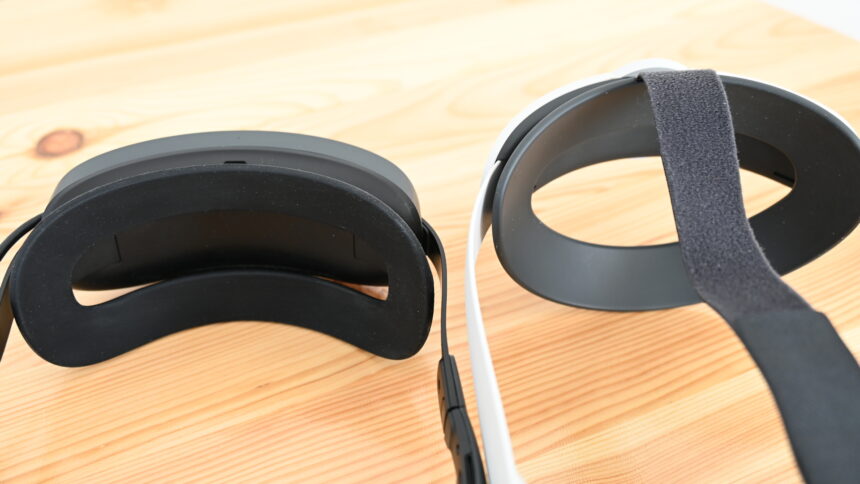
The behind-the-head mounts of the Vive XR Elite (left) and Quest 2 Elite Strap. The XR Elite's oval mount plus the heavy battery are much slipperier than the Quest 2 accessory. | Image: MIXED
The oval design of the rear head mount, which also holds the replaceable battery, is also very slippery. I have to tighten the adjustment wheel quite a bit so that the headset doesn't slip down at the back, reversing the expected advantages of a rear battery.
This, in turn, ensures that the rather tight face mask presses against the forehead at the front. HTC's comfort experts have simply used a bit of stiff fabric as a face mask and attached it to a plastic rail that presses directly against the forehead above the eyes. Combined with the contact pressure needed to keep the battery in place at the back of the head, it gets pretty uncomfortable after 20 minutes, particularly at the front of the forehead.
Why isn't there a normal foam pad for the face? At least the face mask is easy to remove, being magnetically attached. We can only hope for replacement parts that are more comfortable to wear.
Vive XR Elite: sound, software, streaming
The sound of the built-in speakers is okay, but they tend to overdrive. The menu software works well most of the time but is prone to bugs. Sometimes dialog boxes can no longer be clicked away (for example, when trying to mirror the smartphone) — then only a restart helps.
The apps and games for the XR Elite, directly via the store or Viveport, are on a lower level than the Pico Store. Very few well-known titles can be found here, and the offer is generally limited, with about 90 apps at the moment. The Viveport Infinity Program, which is supposed to provide access to many hundreds of VR apps, is not available for the XR Elite at all. That is very surprising for a fresh start in the consumer market.
Given the limited selection of native apps that are currently available, the XR Elite is not worthwhile as a standalone VR headset. At least SteamVR streaming is possible. For that, I again need the usual additional software on my PC, this time the Vive Streaming Hub. HTC has done a very good job with the Wi-Fi streaming setup. I've gotten into SteamVR so quickly, and the button in the system menu that lets me seamlessly switch between native apps and PC VR apps is a stroke of genius. However, PC VR games can only be played mostly smoothly in Performance mode (adjustable in the Vive Streaming Hub). As soon as I want to play on "Quality" or even "Balanced", it clearly jerks too often.
In a direct comparison, Air Link works better for Quest 2 and Quest Pro. Virtual Desktop is not yet available for the Vive XR Elite.
The worst thing for me is streaming via cable, usually the most reliable method, fails entirely. No USB slot, no cable, not even the one included, allowed streaming. I also tested this with Quest Link, and everything worked fine there.
Vive XR Elite as a headset without battery — does that work?
If I unclip the battery and attach the earpieces, I can wear the XR Elite without the battery. This should make it more comfortable when streaming a video and resting against a high-backed chair or lying down. So much for that theory. In practice, the earpieces exert unpleasant pressure on two points on the right and left sides of the back of the head.
However, it is much worse that HTC has repeated the connectivity issues of the Vive Flow. If you lack a Miracast-enabled smartphone, streaming isn't possible. Netflix and the like only work if the smartphone supports HDCP 2.2 copy protection. This list shows which smartphones support "phone mirroring."
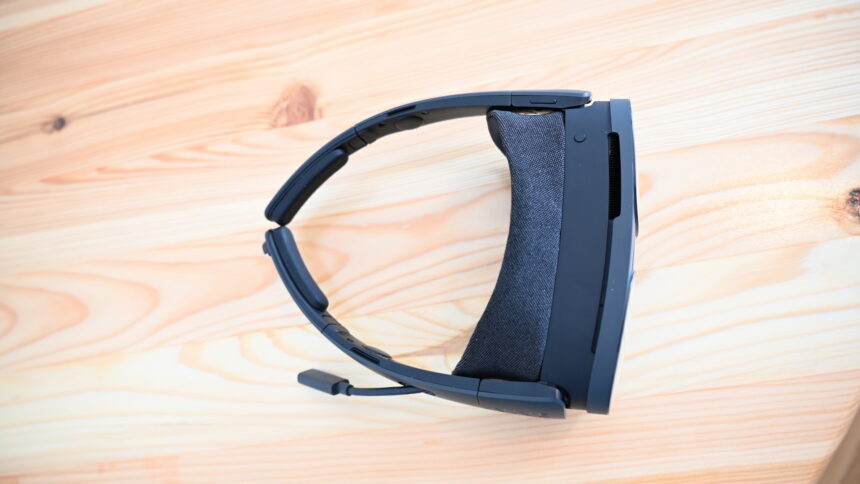
The Vive XR Elite with glasses straps and without a battery is really small — but, unfortunately, isn't functional enough. | Image: MIXED
A direct connection to the phone with USB-C works, but the power is not enough to simultaneously transmit the image and power the headset. I tried this with the Oppo Find X3 and only got a black screen. Some devices with more power provided via USB-C can connect. My laptop works, for example. Streaming also requires a fast Wi-Fi network, which mostly rules out trains or planes.
I cannot watch Prime, Netflix, and other popular streaming websites anyway because of the missing DRM protocol of my smartphone. I have to save movies and videos directly on my smartphone or laptop. Then I can rotate the virtual smartphone screen and watch on a big screen — provided the connection to the smartphone or laptop does not break, which happened to me several times. This should be better.
Passthrough view, a virtual screen in the real environment, also failed to work for me — another missed opportunity.
Privacy
To my knowledge, HTC's privacy policy grants itself fewer rights to pass on data to third parties than, say, Pico or Meta. HTC even categorically excludes this for business purposes.
Another significant advantage compared to other tech companies is that HTC has a clean privacy record and no data protection scandals.
Vive XR Elite conclusion: It will be good next time, for sure, right?
A good VR headset is more than the sum of its parts. It is measured by how well the pieces unite to form a complete experience, including usability. HTC did not create a well-rounded device because they only looked at the form factor, largely forgetting about the actual user experience driven by good software.
It is really unclear to me how they expect to sell this XR headset with these lenses and the partly flawed software for $1,099 to the public.
There's a reason why the Quest 2 is the most popular and best-selling standalone VR headset; it's a well-rounded whole that works mostly flawlessly and stably and is quick and easy to use. There are not enough apps on the XR Elite, nor does PC streaming work well enough.
It could have stood out as a streaming device, but no simple, fast, and direct connection to my smartphone is possible. Instead, I need Miracast, a fast Wi-Fi connection, and a power source strong enough to run the XR Elite in its glasses form without the battery.
This is far too cumbersome, unreliable, unstable, and thus, in my opinion, insufficient for a consumer product — certainly not at this price.
With enough software updates, a working depth sensor, and a better face mask, the XR headset can become a good business XR headset. Perhaps they wanted to evaluate the feedback and field data from individuals to improve the B2B version and let the device mature with the customer.
At the end of the sobering test, I can only recommend the much better Quest Pro in this price range.
You can buy the Vive XR Elite here.
Note: Links to online stores in articles can be so-called affiliate links. If you buy through this link, MIXED receives a commission from the provider. For you the price does not change.